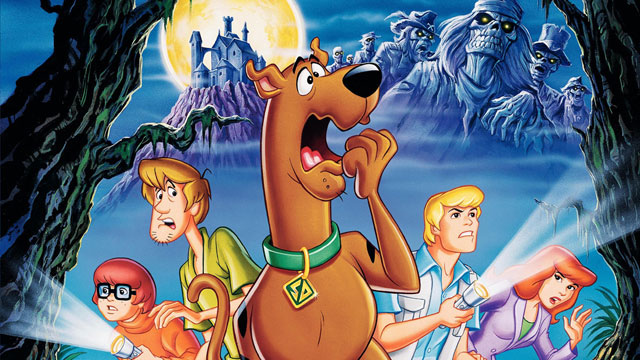“Scooby-Doo, Where Are You?” was my first introduction to the world of Horror Stories, which is weird when you consider that it’s not a horror story at all. I don’t mean that in the sense that it isn’t scary (though it has some great atmosphere), but because it’s the very antithesis of a horror story. Horror is all about the dark forces of chaos and loss of control to something beyond our understanding, of highly emotional violence. Scooby-Doo is usually a detective series, the continuing adventures of a group of kids who set out to prove that the world makes sense by exposing the proverbial Man Behind The Curtain, showing that every horror lurking in the shadows is just some kook in a mask trying to keep people away from whatever illicit business they’re conducting.
The key word is “usually.” As with all long-running properties that central premise sometimes gets altered, as it did with the excellent “Scooby-Doo: Mystery Incorporated” (which steadfastly refuted ghosts, but found a creative loophole in the fringe sciences). Sometimes that central premise gets thrown out entirely, as it did with the execrable “The 13 Ghosts of Scooby-Doo” (the less said about Scrappy-Doo and Flim Flam the better) or the direct-to-video animated feature Scooby-Doo on Zombie Island. The interesting thing about Zombie Island is that it’s not a Scooby-Doo story at all, but a Cormanesque horror flick that’s been de-fanged just enough to be made into an acceptable animated kids movie.
Here’s the plot, minus the twist (which is so outrageous and dumb and needlessly complicated it needs an entire paragraph to itself). Mystery Incorporated has broken up after the group became jaded about none of the paranormal phenomena they investigated ever being real. When Daphne, now a television journalist, expresses nostalgia for the good old mystery-solving days, Fred decides to reunite the old gang and go on a cross-country tour to find a genuine ghost. After a long string of the same old fakery they wind up in Louisiana, where a pretty girl invites them to stay at the genuine haunted house she lives in on a private island along with the house’s owner, an older woman named Simone. Sure enough the gang start to encounter some things that can’t be explained, and find their lives in danger when zombies start clawing their way out of the ground.
And then there’s the movie’s big twist (assuming you don’t count “zombies/ghosts are real!” as a twist), which is so B-movie it hurts. It turns out that the girl who invited Scooby and the gang over to the island and the woman who owns the house are immortal succubi. They were some kind of indigenous white people who worshipped a cat-god, whose tribe was slaughtered by pirates (and when I say “slaughtered,” I mean they ran from the pirates into alligator infested waters and were eaten off-screen). They prayed to their cat-god for revenge, and were transformed into half-human, half-cat demons. Eager to live forever, they began luring people to the island to suck the life out of them, and all the zombies who have been stalking the island are the restless souls of those they murdered, trying to scare off any more potential victims.
It’s not necessarily the plot that reminds me of Corman, because that is more or less cobbled together from half a dozen horror films and, interestingly, predicts a few*. Rather, it’s the pacing, style, and the areas it chooses to cut corners that remind me of the Corman school. The movie is largely confined to a single location, a private home on a remote island in the Southern United States, which in the real world is one of those wonderfully wide open, budget-friendly locations. Then there’s the music, which is obviously where they spent the least amount of money. The score sounds like the really cheap stock music you buy in bulk, and the handful of original songs are painfully generic pop. (Often describing exactly what’s happening on screen)
*There are hints of the found footage genre that would blow up the following year with The Blair Witch Project, and the bare bones of the 2007 Spanish language film [REC], which is about a reporter and her cameraman who get trapped in a quarantined building crawling with maybe-zombies. (Though it should be noted that when shit starts getting really dangerous, Fred stops filming so he can get away faster. Take note, future found-footage cameramen.)
Then there’s the voice acting. The movie somehow managed to assemble a murderer’s row of voice acting talent (Billy West! Mary Kay Bergman! Frank Welker! Tara Strong [under her maiden name Charendorff]! Jim Cummings! Mark Hamill!) and for the most part there’s very little life to the performances. A lot of this can be attributed to the lackluster script (some of the dialogue is atrocious), which gives no characterization whatsoever to the Scooby gang beyond what might be found on a Wikipedia entry. The only people who don’t sound like they’re thinking about where else they could be are Hamill, who lucked into an outrageously bizarre stereotype, and Strong, who I’m pretty sure gives 100% when she says hello to strangers on the street.
Finally, there’s the animation, which is well done (Scooby-Doo himself is elastic and bursting with energy), but mixes aesthetics in a way that makes the whole movie seem a little off. The film was largely animated in Japan, and as such there’s a distinct anime influence on the project. It’s much more subtle in the Scooby gang, since they’re working from pre-existing designs, but a lot of the original characters look like they wandered in from “Sailor Moon.” (This comparison is especially apt when Simone and her protege transform into cat-demons)
Scooby-Doo On Zombie Island is an odd little movie, and I might recommend it solely because I can’t think of anything else quite like it.


